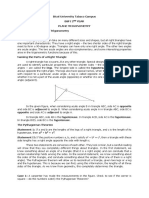Right Triangles: Pythagorean Theorem Right Triangle Hypotenuse
Uploaded by
RatulKumarMajumdarRight Triangles: Pythagorean Theorem Right Triangle Hypotenuse
Uploaded by
RatulKumarMajumdarRight triangles
The Pythagorean theorem
A central theorem is the Pythagorean theorem, which states in any right triangle, the square of the
length of the hypotenuse equals the sum of the squares of the lengths of the two other sides. If the
hypotenuse has length c, and the legs have lengths a and b, then the theorem states that
The converse is true: if the lengths of the sides of a triangle satisfy the above equation, then the
triangle has a right angle opposite side c.
Some other facts about right triangles:
The acute angles of a right triangle are complementary.
If the legs of a right triangle have the same length, then the angles opposite those legs
have the same measure. Since these angles are complementary, it follows that each
measures 45 degrees. By the Pythagorean theorem, the length of the hypotenuse is the
length of a leg times 2.
In a right triangle with acute angles measuring 30 and 60 degrees, the hypotenuse is
twice the length of the shorter side, and the longer side is equal to the length of the
shorter side times 3:
You might also like
- Colorful Playful Illustrative Pythagorean Theorem Education Presentation - 20240225 - 114846 - 0000No ratings yetColorful Playful Illustrative Pythagorean Theorem Education Presentation - 20240225 - 114846 - 000013 pages
- Pythagoras Theorem Pythagoras Theorem: Mathematics Project Mathematics ProjectNo ratings yetPythagoras Theorem Pythagoras Theorem: Mathematics Project Mathematics Project15 pages
- Colorful Playful Illustrative Pythagorean Theorem Education PresentationNo ratings yetColorful Playful Illustrative Pythagorean Theorem Education Presentation13 pages
- Colorful Playful Illustrative Pythagorean Theorem Education Presentation - 20240430 - 084931 - 0000No ratings yetColorful Playful Illustrative Pythagorean Theorem Education Presentation - 20240430 - 084931 - 000013 pages
- Learner's Activity Sheet: Mathematics (Quarter III - Week 8)No ratings yetLearner's Activity Sheet: Mathematics (Quarter III - Week 8)7 pages
- Welcome To Math With Professor: Pythagorean Theorem and Its OrigionsNo ratings yetWelcome To Math With Professor: Pythagorean Theorem and Its Origions10 pages
- The Love Triangle Pythagorean Theorem and Distance FormulaNo ratings yetThe Love Triangle Pythagorean Theorem and Distance Formula12 pages
- 10th Grade NCERT Pythogaras Theorem NotesNo ratings yet10th Grade NCERT Pythogaras Theorem Notes3 pages
- Centre Radius Diameter Circumference Chord Tangent ArcNo ratings yetCentre Radius Diameter Circumference Chord Tangent Arc39 pages
- Pythagorean_Theorem_Expanded_Fixed_EncodingNo ratings yetPythagorean_Theorem_Expanded_Fixed_Encoding3 pages
- Colorful Playful Illustrative Pythagorean Theorem Education PresentationNo ratings yetColorful Playful Illustrative Pythagorean Theorem Education Presentation13 pages
- Chapter08 - Trigonometry Ratio SOH CAH TOANo ratings yetChapter08 - Trigonometry Ratio SOH CAH TOA37 pages
- My Sat/Act Math Book: Karla Perera 1st EditionNo ratings yetMy Sat/Act Math Book: Karla Perera 1st Edition5 pages
- MATHS PROJECT Kendriya Vidyalaya No.1 Chakeri Kanpur, InDIA83% (6)MATHS PROJECT Kendriya Vidyalaya No.1 Chakeri Kanpur, InDIA57 pages
- QIII Lesson 6 Similarities in Right Triangles 1No ratings yetQIII Lesson 6 Similarities in Right Triangles 132 pages
- The Pythagorean Theorem Presentation in Dark Green Orange Illustrative StyleNo ratings yetThe Pythagorean Theorem Presentation in Dark Green Orange Illustrative Style12 pages
- Pythagorean Theorem - History, Applications, and ProofsNo ratings yetPythagorean Theorem - History, Applications, and Proofs43 pages
- MATH'S Project Report On Pythagoras Theorem Submitted To Mr. Munish Sharma Submitted by Class - X-B ROLL. NO.13 Uspc Jain Public School100% (1)MATH'S Project Report On Pythagoras Theorem Submitted To Mr. Munish Sharma Submitted by Class - X-B ROLL. NO.13 Uspc Jain Public School5 pages
- Basic Facts: Dimensional Plane Figures Non-Planar Triangles Polytope EuclidNo ratings yetBasic Facts: Dimensional Plane Figures Non-Planar Triangles Polytope Euclid1 page
- Trigonometric Functions Angle TrigonometryNo ratings yetTrigonometric Functions Angle Trigonometry1 page
- Genetic Analysis Snow Leopard: Panthera ZdanskyiNo ratings yetGenetic Analysis Snow Leopard: Panthera Zdanskyi1 page
- Condition On The Sides: Triangle InequalityNo ratings yetCondition On The Sides: Triangle Inequality1 page
- Similarity and Congruence: Theorems If and Only IfNo ratings yetSimilarity and Congruence: Theorems If and Only If1 page
- Polygon Edges Vertices Shapes Geometry Euclidean Geometry Plane Euclidean SpaceNo ratings yetPolygon Edges Vertices Shapes Geometry Euclidean Geometry Plane Euclidean Space1 page
- Trinil Tiger Trinil Java Beringia Japan SakhalinNo ratings yetTrinil Tiger Trinil Java Beringia Japan Sakhalin1 page
- Charismatic Megafauna Mythology Folklore Flags Coats of Arms Mascots National Animal Bangladesh India Malaysia South KoreaNo ratings yetCharismatic Megafauna Mythology Folklore Flags Coats of Arms Mascots National Animal Bangladesh India Malaysia South Korea1 page
- Sense of Balance Fight-Or-Flight Response Mares Foal Saddle HarnessNo ratings yetSense of Balance Fight-Or-Flight Response Mares Foal Saddle Harness1 page
- Lifespan and Life Stages: Management Old BillyNo ratings yetLifespan and Life Stages: Management Old Billy1 page
- European or "Taurine" Cattle Zebu Aurochs: Taurus Primigenius, Bos Taurus Indicus, and Bos Taurus TaurusNo ratings yetEuropean or "Taurine" Cattle Zebu Aurochs: Taurus Primigenius, Bos Taurus Indicus, and Bos Taurus Taurus2 pages
- Orphanage Adopting Hobart, Tasmania Self-HarmNo ratings yetOrphanage Adopting Hobart, Tasmania Self-Harm1 page
- European or "Taurine" Cattle Zebu Aurochs: Primigenius, The Primigenius, Bos Taurus Indicus, and Bos Taurus TaurusNo ratings yetEuropean or "Taurine" Cattle Zebu Aurochs: Primigenius, The Primigenius, Bos Taurus Indicus, and Bos Taurus Taurus1 page

























































































